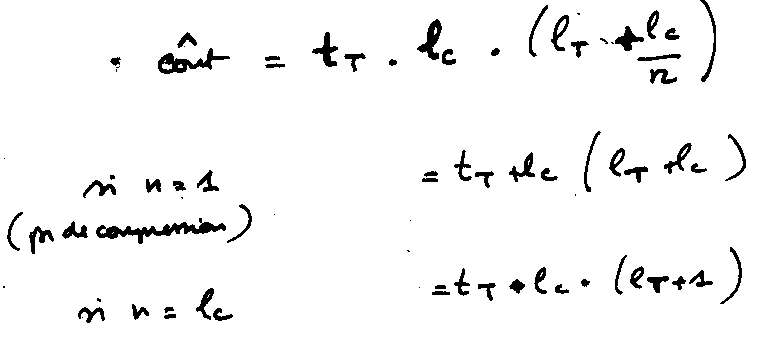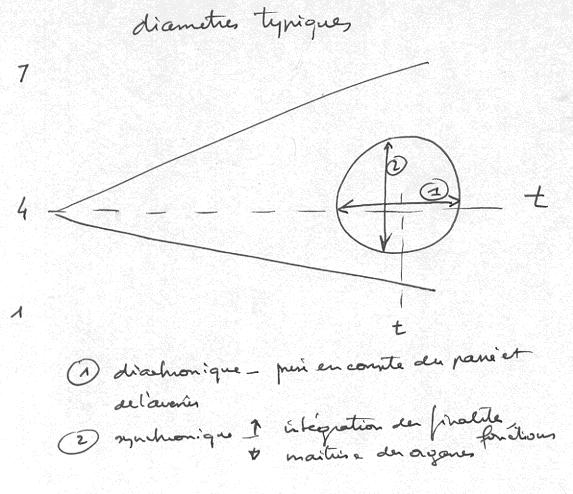Time
1. Bases
- Time in the "living art", see [Aziosmanoff] p. 107 sq..
- In synthetic cinema, a program is executed, real time, for each image, if the computer is quick enough to provide images at the proper rhythm (FPS, frame per second). About textures here, see for instance [Ebert].
- Real time. A concept looking intuitively simple, but very difficult to be defined. See special note (in French) .
- Timeline. - "A clear sens of the time-span of the story is necessary to define the plot.. will define in the first instance the period of time that the story spans, be it ten weeks, ten months or ten years." ([Bernardo]).
Time in the digital world is strongly
- Oriented ; at low level by cycles ; at high level by Moore
- Cyclical (depends on which level)
- There are addresses in time (date), and assertions can be date : there (date as well as site) is (was, will be) that. But also : there (pointer) is a time variable.
In the real world also : Day and
night. AM/PM. Early/late. Calendar. History.
Beginning/end. Past/present. Instant
Cinema, digital or not, plays a lot with time. Cuts and mounting are what make cinema an art and not only a data capture.
In a digital environment, time may be taken just as another dimension. Of course, this dimension has specific features, mainly irreversibility, if we wan to remain credible as a representation of real actions.
Time may accelerated, or slowed, or even reversed.
Some deeper operations can be done (permute time with any of the three spacial dimensions)... Diffcicult to get something meaningful beyond some fun.
Time offset and video effects: just a small ofsset image combined with the present gives graphic effects.
Longer offsets, or instance 24 hours, give psychological effects (some installations).
Time cycles. Frequency. Amplitude. Phase. Resonance.
Antique hours. Equal hours
Time may be considered as just one more dimension of DU. but with particular features beginning with its irreversibility.
Instant and bit. A cut or a small part in the time line ?
2. Clocks
Part of digital devices have their own clock. , this base is operated by the elementary clocks. Hence, Bailly-Longo proffers depreciative appreciations of machines. Digital time would be "a Newtonian absolute" and "the time of the myth, proper to Greek poetry". In fact, it is only in particular case, in "real time" programming, that this clock time plays explicitly a role. Normal operations use standard time references (which are digital, of course). And Bailly-Longo say of "time of myth".
At first look, this dimension seems orthogonal to space dimensions. But, as a lot of operations are time dependent, this must be elaborated, as Einsteinian relativity has shown for the physical world.
This model is simple only if we admit that there is a general clock beating for the whole universe. But actually, a lot of beings have their own clock, and the synchronization, necessary to communication, may introduce some sort of continuity.
Time in the basic automaton model. A given being may be considered as a sequence of states, with possibly a starting state (original state) and a final state.
The clock. A bit is enough,
if it is at random.
But aim to a clock's autonomy is assert its difference, its comparison and its
randomness in relation to the cycle of the accessing being. And, to see that,
one bit is not enough. we need a succession of bits in time.
Number of cycles in a system (see Bailly)
Temporal mass in R4 : integral of masses through time.
There are some analog clocks, in Antiquity. Of little use.
Part of digital devices have their own clock. , this base is operated by the elementary clocks. Hence, Bailly-Longo proffers depreciative appreciations of machines. Digital time would be "a Newtonian absolute" and "the time of the myth, proper to Greek poetry". In fact, it is only in particular case, in "real time" programming, that this clock time plays explicitly a role. Normal operations use standard time references (which are digital, of course). And Bailly-Longo say of "time of myth".
3. Representations of time
Representations of time allow prediction and history and bring some kind of reversibility.
More and more digital along the centuries. Sundial. Equal hours clocks in middle-ages (check)
We could see life as put
in rhythm by a general two phased cycle. In one phase, each processor runs its
program, i.e. processes the O(I,E) and E(I,E) functions. In the other one, the
O are transmitted to the specified I. We can consider that
- this transmission function is operated by a general Com program
- or that that each processor emits towards all the others, each one making do
to take what is useful for it.
The choice between the two systems is more an optimization than a fundamental question. If there is a general Com program, it has to know where are the processors and the free regions. Actually, with a smart Com, we could have all sort of beings in the general space, with protections, etc.
Time, as well as all the
beings and GG may be rastered. Periodical structures. More elaborated
structures (variable length).
Classical case: signal sampling.
Transversality in respect to time


Time depth and complexity (?)
4. Temporality and scheduling
Life in dibital universes is also digital,
with changes taking place in a null duration instant, and states before and
after. It is controlled mainly by the clocks incorporated in part of the
beings. The clock is the minimal agent.
The digital universe could be considered globally as an agent with its own clock, possibly even
with the unique clock, controlling or triggering all the other clocks. But that
is not possible due to DR, which prevents control at long distance.
Nevertheless, it may be practical at some times to think of a generally controlling GOS, operating in two phases. In the first one, each being executes its own functions O(I,E) et E(I,E). In the other one, the O's are transmitted to the I's.
And that is necessarily true in some subspaces, and specially in any being, at least in an being core with its clock and basic functions. Large beings could have non synchronized parts (for instance larger memories)
Time as well as any form in DU, may be organized in larger structures, periodical or not. We must think that GOS has something like an eternal life. Bits also. Intermediate structures will have finite life cycles.
In the automaton model, time is oriented. O's follow I's. A program is the scheduling of functions by succession, with possible parallelism. A program is precisely the scheduling of a function by a succession.
5. Life cycle of a being
Part of the gap: ontogenesis duration, which is not negligible in relation to phylogenesis, at least in the recent periods. Somehow, an important moment in History is when the most evolved beings have had an ontogenesis time in the same order as the historical events, as several phylogeneses. Then they see the world changing. (A man is eternal for a rose (Candide, by Voltaire ? )). "De mémoire de rose).
For a rather simple machine, the life cycle (reliabitity bathtub curve) is largely flat. For complex machines, at least some of them, there is a surge to maturity. That is true at least for those which have complex relations with their environment, since the environment itself has to adapt. Then, there is a surge to maturity, then decay. That is due not only to wear and tear of the being, but also to its obsolescence due to the environment evolution (and better system models emerging).
The stability of a given family is artificially maintained beyond its natural obsolescence (e.g. material of functional) by its functional performance for a population of users.
Cycles may be nested in large cycles. Or be in succession.
If E is very large, it structures itself progressively, by autostructuration (innovation research) or by technology acquisition. Intermediate solution : learning.
After that, we can assume,
more realistically, that there are "synchronous (sub-)spaces", beyond
with some sort of synchronization is necessary (see DR).
Inside a synchronous space, a clock sets the time. It may be given with a
simple looped gate. By definition, an elementary time it this space is then a
cycle of this clock.
6. Behaviour
Behaviour
has a time structure.
Method is a structure in time (succession)
Music, cinema, dance, clock.
Cinema : continuity reached by a succession of still images.
Real time.
7. Notes on Delahaye
DELAHAYE Jean-Paul : Information, complexité et hasard. Hermès. 2eme édition 1999.
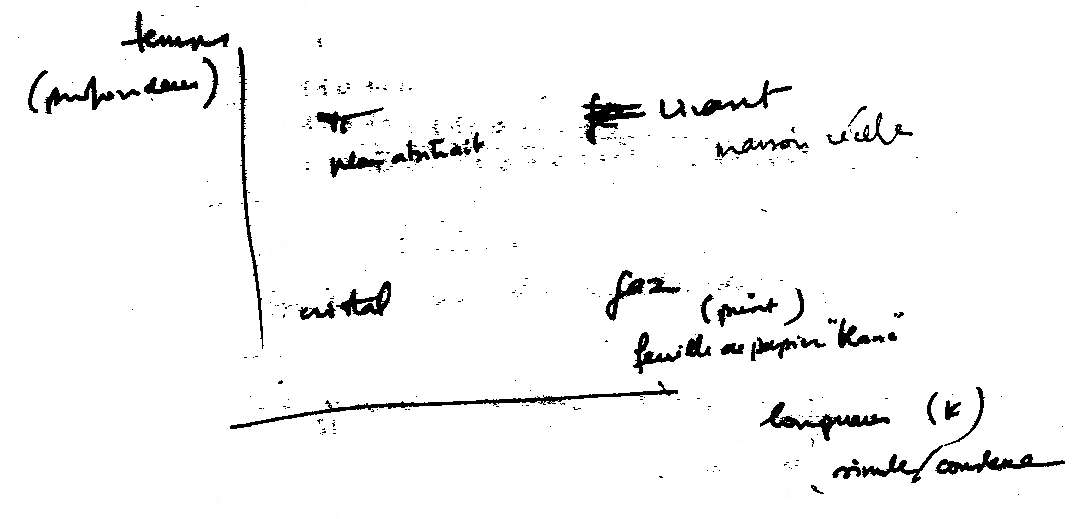
If we compress, we lengthen.
p10 1) We could the the abstract plane (?) if we have a powerful computer
at hand.
2) not simply plane . see Atlan. in genome, in relation to optimal plane, redundant
parts, useless parts, introns, equivalence of codons.
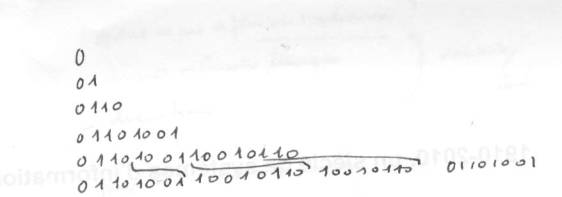
Issue to be solved : minimal size of a universal Turing machine (see something
in Li).
wit its series, Delahaye has a functional approach, produce S
k(S) : length of the smallest program which generates
no hypothesis on cycle count
Algorithmic complexity class P
time PSPACE
(memory) space
program length K
Bennett : depth, computing time for the minimal program.
PB : time, length.
or lenth of P + memory (E, actually).

What has an impactd on the optimum ?
- memory/length avalability
- time availabilty
proportion between phases
aesthetic, harmony
105/1. the translation of the plane into object is as longer that superior animal,
biological matuation, temps, acculturation, learning.
106. we could try sob (small object)
due to interesting properties, root, ex. the {0,1} group
organized complexity : long deployment (many steps)
a simple idea
at the limite
infinite, and the bit itsefl
For a given string, there are several possible p
the most rapid, print + the string
the longest, minimal pg in length
why length ? with a "rather length" (K lents), ans sufficiently rapid
families.
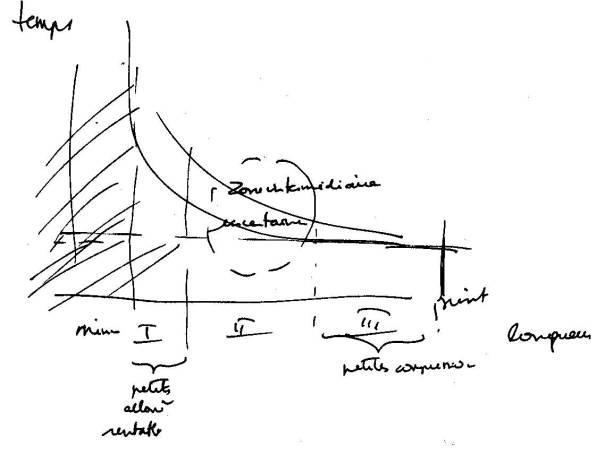
The curve allure, in the three zones I,II, III, must vary according to the
problem (cf. p 156 )
- 1 non compressible string, length of program + strring length. print_time
* string length
- 2 small compressing, coded in bytes, we see that there is only digital ; take
it back to one numerical character per byte, 8 bits to 4 bits.
print + transcode

- length ) print + decode + l(string)/2
- time ) (print + decode) * l(string)/8
total cost : - lt = (time + power) * memory size
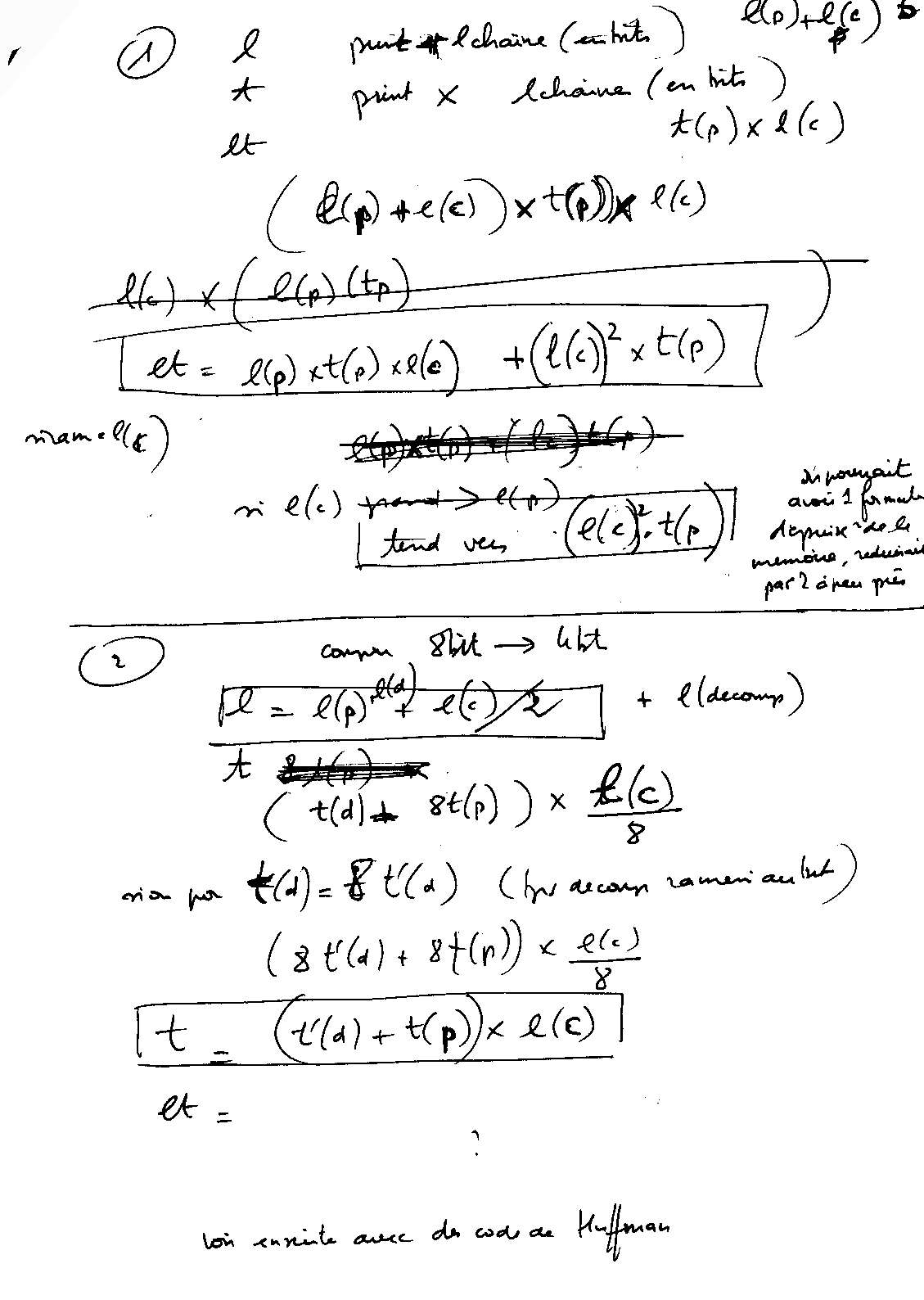
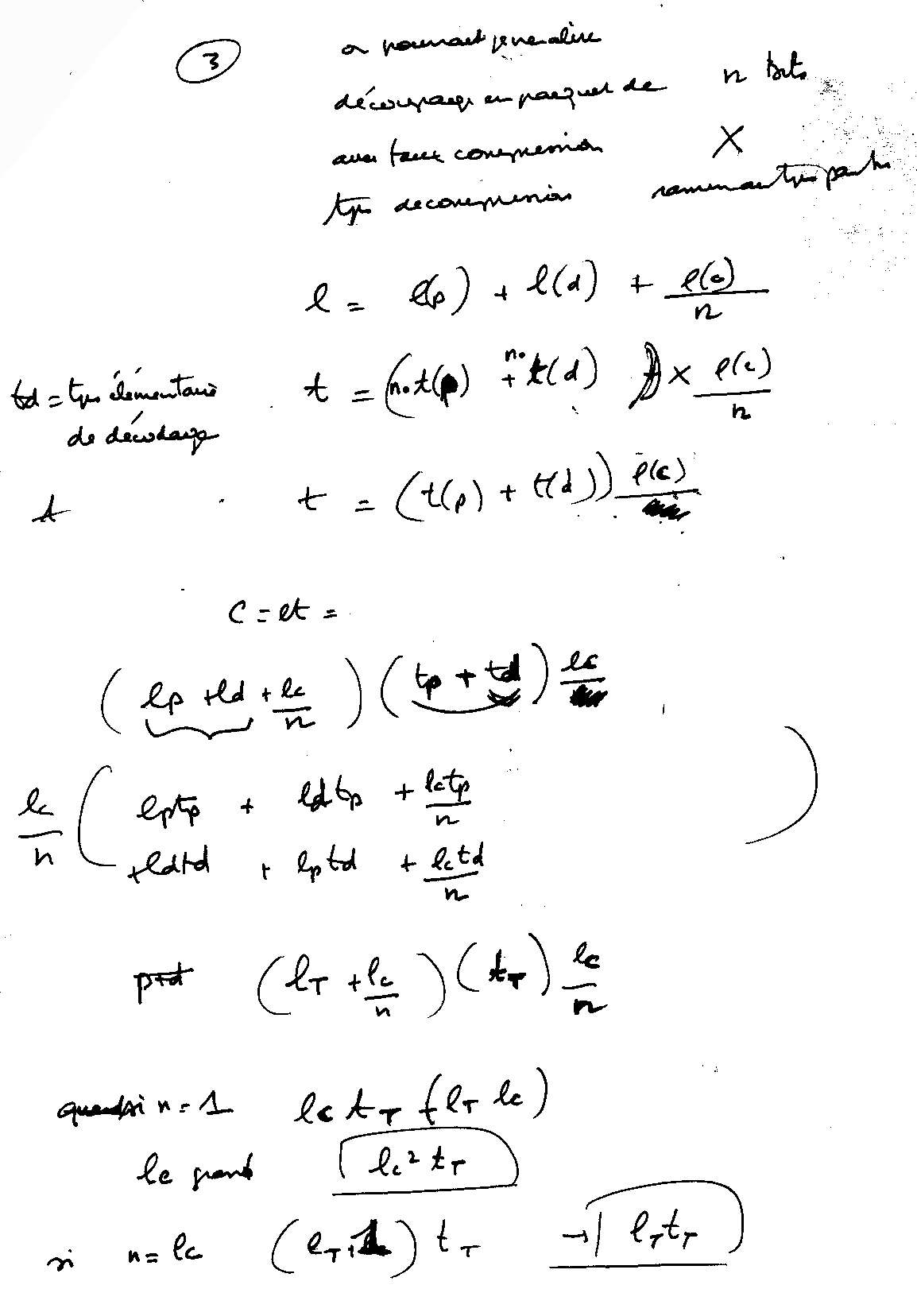
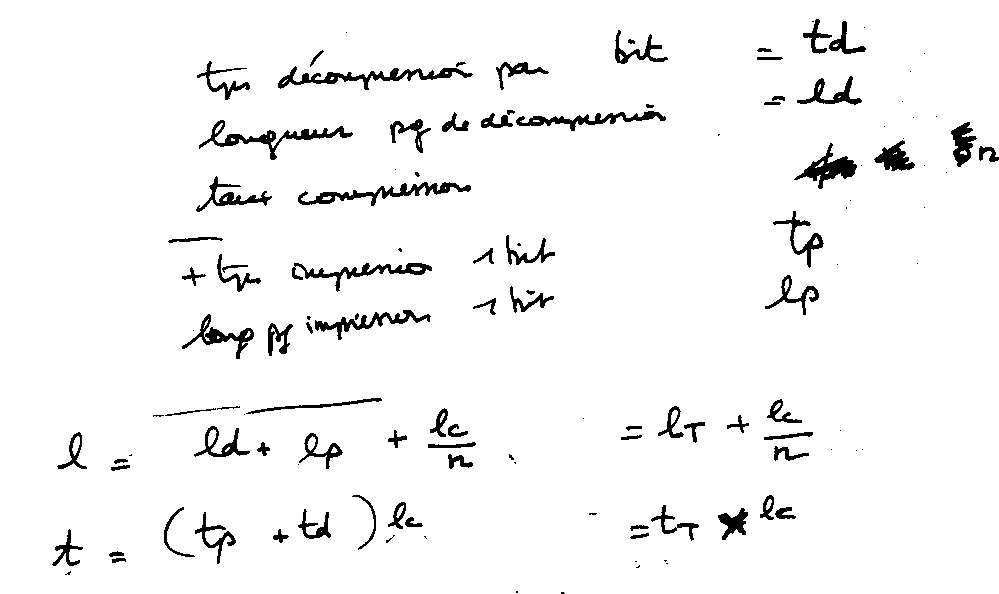
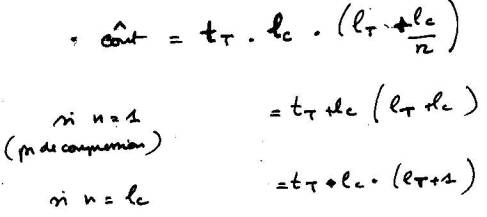
(We have supposed that the decompression time per bit is constant)
What means dire letnt?
In biological temrs, what is cycle ?
for a crystal
indefinite repetition (but not infinite) of a sequence
l : print the sequence + repet.
t infinite or ltotal/lcristal * t(print)
8. Varia
See Couchot book
Chronos
20. inherent time to the work of art
50, 103, resonane
87. foliot, digitizing
9. (Quotations sent by Jean-Paul Bois ? )
Qu'est-ce donc que le temps ? Si personne ne me le demande, je le sais; mais
si on me le demande et que je veuille l'expliquer, je ne le sais plus. Pourtant,
je le déclare hardiment, je sais que si rien ne passait, il n'y aurait
pas de temps passé; que si rien n'arrivait, il n'y aurait pas de temps
à venir; que si rien n'était, il n'y aurait pas de temps présent.
Comment donc, ces deux temps, le passé et l'avenir, sont-ils, puisque
le passé n'est plus et que l'avenir n'est pas encore ? Quant au présent,
s'il était toujours présent, s'il n'allait pas rejoindre le passé,
il ne serait pas du temps, il serait l'éternité. Donc, si le présent,
pour être du temps, doit rejoindre le passé, comment pouvons-nous
déclarer qu'il est aussi, lui qui ne peut être qu'en cessant d'être
? Si bien que ce qui nous autorise à affirmer que le temps est, c'est
qu'il tend à n'être plus [...]
Ce qui m'apparaît maintenant avec la clarté de l'évidence,
c'est que ni l'avenir, ni le passé n'existent. Ce n'est pas user de termes
propres que de dire “ Il y a trois temps, le passé, le présent
et l'avenir. ” Peut-être dirait-on plus justement “ Il y a
trois temps le présent du passé, le présent du présent,
le présent du futur. ” Car ces trois sortes de temps existent dans
notre esprit et je ne les vois pas ailleurs. Le présent du passé,
c'est la mémoire; le présent du présent, c'est l'intuition
directe; le présent de l'avenir, c'est l'attente. Si l'on me permet de
m'exprimer ainsi, je vois et j'avoue qu'il y a trois temps, oui, il y en a trois.
Que l'on persiste à dire “ Il y a trois temps, le passé,
le présent et l'avenir ”, comme le veut un usage abusif, oui qu'on
le dise. Je ne m'en soucie guère, ni je n'y contredis ni ne le blâme,
pourvu cependant que l'on entende bien ce qu'on dit, et qu'on n'aille pas croire
que le futur existe déjà, que le passé existe encore. Un
langage fait de termes propres est chose rare : très souvent nous parlons
sans propriété, mais on comprend ce que nous voulons dire.
Saint Augustin
354-430
Le passage du présent à un autre présent, je ne le pense
pas, je n'en suis pas le spectateur, je l'effectue, je suis déjà
au présent qui va venir comme mon geste est déjà à
son but, je suis moi-même le temps, un temps qui “ demeure ”
et ne “ s'écoule ” ni ne “ change ”, comme Kant
l'a dit dans quelques textes. Cette idée du temps qui se devance lui-même,
le sens commun l'aperçoit à sa façon. Tout le monde parle
du temps, et non pas comme le zoologiste parle du chien ou du cheval, au sens
d'un nom collectif, mais au sens d'un nom propre. Quelquefois même, on
le personnifie. Tout le monde pense qu'il y a là un seul être concret,
tout entier présent en chacune de ses manifestations comme un homme est
dans chacune de ses paroles. On dit qu'il y a un temps comme on dit qu'il y
a un jet d'eau: l'eau change et le jet d'eau demeure parce que la forme se conserve;
la forme se conserve parce que chaque onde successive reprend les fonctions
de la précédente: onde poussante par rapport à celle qu'elle
poussait, elle devient à son tour onde poussée par rapport à
une autre; et cela même vient enfin de ce que, depuis la source jusqu'au
jet, les ondes ne sont pas séparées: il n'y a qu'une seule poussée,
une seule lacune dans le flux suffirait à rompre le jet. C'est ici que
se justifie la métaphore de la rivière, non pas en tant que la
rivière s'écoule, mais en tant qu'elle ne fait qu'un avec elle-même.
Seulement, cette intuition de la permanence du temps est compromise dans le
sens commun, parce qu'il le thématise ou l'objective, ce qui est justement
la plus sûre manière de l'ignorer. Il y a plus de vérité
dans les personnifications mythiques du temps que dans la notion du temps considéré,
à la manière scientifique, comme une variable de la nature en
soi ou, à la manière kantienne, comme une forme idéalement
séparable de sa matière. Il y a un style temporel du monde et
le temps demeure le même parce que le passé est un ancien avenir
et un présent récent, le présent un passé prochain
et un avenir récent, l'avenir enfin un présent et même un
passé à venir, c'est-à-dire parce que chaque dimension
du temps est traitée ou visée comme autre chose qu'elle-même
— c'est-à-dire enfin parce qu'il y a au cœur du temps un
regard, ou, comme dit Heidegger, un Augenblick, quelqu'un par qui le mot comme
puisse avoir un sens.
Maurice Merleau-Ponty
a) Le temps n est pas quelque chose qui existe en soi, ou qui soit inhérent
aux choses comme une détermination objective, et qui, par conséquent,
subsiste, si l'on fait abstraction de toutes les conditions subjectives de leur
intuition; dans le premier cas, en effet, il faudrait qu'il fût quelque
chose qui existât réellement sans objet réel. Mais dans
le second cas, en qualité de détermination ou d'ordre inhérent
aux choses elles-mêmes, il ne pourrait être donné avant les
objets comme leur condition, ni être connu et intuitionné a priori
par des propositions synthétiques; ce qui devient facile, au contraire,
si le temps n'est que la condition subjective sous laquelle peuvent trouver
place en nous toutes les intuitions. Alors, en effet, cette forme de l'intuition
intérieure peut être représentée avant les objets
et, par suite, a priori.
b) Le temps n'est autre chose que la forme du sens interne, c'est-à-dire
de l'intuition de nous-mêmes et de notre état intérieur.
En effet, le temps ne peut pas être une détermination des phénomènes
extérieurs, il n'appartient ni à une figure, ni à une position,
etc.; au contraire, il détermine le rapport des représentations
dans notre état interne. Et, précisément parce que cette
intuition intérieure ne fournit aucune figure, nous cherchons à
suppléer à ce défaut par des analogies et nous représentons
la suite du temps par une ligne qui se prolonge à l'infini et dont les
diverses parties constituent une série qui n'a qu'une dimension, et nous
concluons des propriétés de cette ligne à toutes les propriétés
du temps, avec cette seule exception que les parties de la première sont
simultanées, tandis que celles du second sont toujours successives. Il
ressort clairement de là que la représentation du temps lui-même
est une intuition, puisque tous ses rapports peuvent être exprimés
par une intuition extérieure.
c) Le temps est la condition formelle a priori de tous les phénomènes
en général. L'espace, en tant que forme pure de l'intuition extérieure,
est limité, comme condition a priori, simplement aux phénomènes
externes. Au contraire, comme toutes les représentations, qu'elles puissent
avoir ou non pour objets des choses extérieures, appartiennent, pourtant,
en elles-mêmes, en qualité de déterminations de l'esprit
à l'état interne, et, comme cet état interne est toujours
soumis à la condition formelle de l'intuition intérieure et que,
par suite, il appartient au temps, le temps est une condition a priori de tous
les phénomènes en général et, à la vérité,
la condition immédiate des phénomènes intérieurs
(de notre âme), et, par là même, la condition médiate
des phénomènes extérieurs.
Kant



